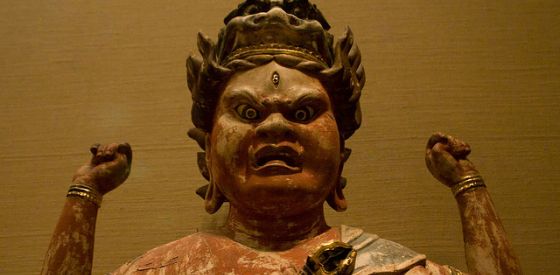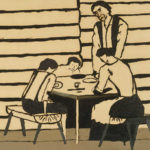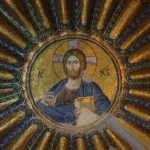We run our website the way we wished the whole internet worked: we provide high quality original content with no ads. We are funded solely by your direct support. Please consider supporting this project.

Cruciform Aikido Pt 1: Jesus and the Violent God
Note: Today, we are beginning a 4-part series on the subject of divine judgement called “Cruciform Aikido.” We will be publishing this once a week alongside Greg’s introduction to ReKnew series.
When most people think of God judging sinners, they imagine an angry God who acts violently as he vents his wrath and brings vengeance on people. Many base this understanding on various portraits of God judging people in the Old Testament (OT). (The book of Revelation also symbolically depicts God and Christ in violent ways, but that is a topic for a later blog.) There’s no question that some portraits of God in the OT depict him acting violently as he judges people. But these violent portraits are very hard to reconcile with the embodied revelation of a non-violent, enemy-loving God that we have in Jesus. Instead of calling on legions of angels to crush his enemies, Jesus offered himself up on their behalf, allowing them to crucify him while praying for their forgiveness with his last breath (Mt 26:53; Lk. 23:34). Since Jesus is the one and only perfect revelation of God’s essence (hupostasis, Heb 1:3), our understanding of God’s character and judgments ought to be anchored solely in him.
Moreover, since all Scripture is written to bear witness to Christ (Jn 5:39-40, 46-47; Lk 24: 44-45), the OT’s violent portraits of God ought to be interpreted through the lens of Christ. While all Scripture is divinely inspired, it was not intended to carry the same weight for all people throughout history. Hence, for example, while Jesus declared that John the Baptist was the greatest of all prophets leading up to him, Jesus declared that his own “testimony” was “weightier” (megas) than that of John (Jn 5:36). The revelation of God in Christ must therefore be given more weight than that of John and therefore be considered to carry more authority than any OT author prior to John. Though God certainly “breathed” (theopneustos; 2 Tim 3:16) through Old Testament authors, they did not know “the Word of God in fullness,” which was the “mystery” that had “been kept hidden for ages and generations” (Col. 1:25-26). This “mystery” was the truth of God’s humble, self-sacrificial, loving character–the character that was fully revealed only when God united himself to humanity in Christ and dwelt within his people by the Spirit of Christ–“Christ in you, the hope of glory” (Col. 1:26).
Given the supremacy of the revelation of God in Christ, we must consider the cross to be the quintessential revelation of God’s judgment. And as we will show in the next few blogs, this revelation means that the nature of God’s judgment is very different from the violent understanding that some OT authors had, and that many people today have.
Image by Orin Zebest. Used with Permission. Sourced via Flickr.
Category: General
Tags: Cruciform Theology, Old Testament, Violence
Related Reading

Are You Guilty of Marcionism?
Greg responds to the question of whether or not his cruciform hermeneutic is anything like the heresy of Marcion, who basically advocated throwing out the Old Testament. (Spoiler: it’s not.)

Did Yahweh Crush His Son?
Though Isaiah was probably referring to the nation of Israel as Yahweh’s “suffering servant” when these words were penned, the NT authors as well as other early church fathers interpreted this servant to be a prophetic reference to Christ. Speaking proleptically, Isaiah declares that this suffering servant was “punished” and “stricken by God” (Isa 53:4,…

Podcast: Why Must God Wait for Prayer to Meet Our Needs?
Is God a bad father? Greg explores the intricacies and nuances of prayer. http://traffic.libsyn.com/askgregboyd/Episode_0404.mp3

Sermons: The Church – Week Five
In week five of this sermon series, Greg Boyd discusses what the church should look like in the lens of the cross. A universal Church was born out of the ministry of Jesus, and this Church is empowered to look like the Cross. In this sermon, Greg shows us why it’s so important, as the…

Modern Theologians and the Centrality of Christ
During the twentieth century the development of a Christocentric reading of the Scriptures—which is crucial to understanding what I argue in Crucifixion of the Warrior God—surged in the wake of Karl Barth’s publication of his Romans commentary in 1916. It was justifiably described as a “bombshell” that fell “on the playground of the theologians,” demolishing…

Christus Victor Atonement and Girard’s Scapegoat Theory
Many of the major criticisms of Crucifixion of the Warrior God that have been raised since it was published four weeks ago have come from folks who advocate Rene Girard’s understanding of the atonement. A major place where these matters are being discussed is here, and you are free to join. Now, I have to…
